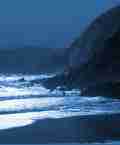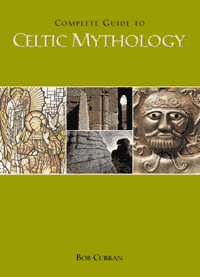 |


|
|||
 The Tuatha Dé Danann and the Sidhe In 12th-century Ireland, a book appeared which was to play a central role in the mythology and folklore of the country. This was the Leabhar Gabhála – The Book of Invasions which took its material from much older vernacular sources. Portions of the original text survive in other ancient manuscripts such as the 12th–century Book of Leinster. The Irish writer Micheál Ó Cléirigh (1575–1645) compiled a version in which he used several very old texts that have since been lost and it is generally this version that is referred to when speaking of the book. The Book of Invasions set out to detail a history of Ireland, from a period preceding the Deluge up to the reign of the High King Malachai Mór (ad 980–1002). It alluded to successive invasions of the country by strange peoples from across the sea. The first centuries bc were notable for migrations of peoples so there might be some truth in the text but much of it is highly mythologised. It was treated as history in many cases, though, and rapidly became the National Epic of Ireland. It is the fifth of the invading groups that pertains to this section. They are referred to in the book as the Tuatha Dé Danann – ‘The People (or Children) of the Goddess Danu’. They were said to have come from the east in a golden mist and were a race of divine beings, who inhabited Ireland immediately preceding the coming of the ancestors of the Gaels or Celts who were the sons of Mil or Milesians. They arrived in Ireland to find it already settled by the previous invaders, the Fir Bholg – literally ‘bog men’ – against whom they fought a mighty battle known as the First Battle of Magh Tuireadh. The second battle at Moytirra, County Sligo, soon followed, this time against the Fomorians (or Fomorii – see Giants, Monsters and Fairies), a misshapen, monstrous and violent race who dwelt partly in the sea. They represented the evil spirits of Irish myth and were centred on Tory Island, off the Donegal coast, ruled by their gigantic, one-eyed king, Balor. In the First and Second Battles of Magh Tuireadh, the Tuatha Dé Danann were successful, their victory being attributed to their supernatural powers and to the potency of the magic talismans and sorcerous artefacts that they had brought with them. If there is a glimmer of truth in the legend of the Tuatha Dé Danann, we wonder where they came from. Some Irish historians and folklorists such as Peter Beresford- Ellis have suggested that they might have been a displaced Grecian race whose knowledge, borrowed from the Mediterranean cultures, was far superior to that of the indigenous Irish. They cite the phrase ‘the East’ as a traditional point of origin for these people, stating that this may be somewhere in the Mediterranean. Others have suggested that they were themselves a proto-Celtic race, pointing to the primacy of the Mother-Goddess Danu and noting her frequent confusion with Anu, a fertility goddess specific to Ireland. It is highly probable that the two goddesses were in fact one, a remnant of an earlier Celtic period. Some versions of the invasion story specifically state that the Tuatha Dé Danann had come from the Otherworld, which was the source of their mysterious powers, and that they returned there after the coming of the Celts. There is no doubt in the ancient texts that the Tuatha were wise in magic and in druid lore. Many of their chieftains were powerful gods such as The Daghdha – the ‘Good God’ – who was both a warrior and a druid of frightening power. They were greatly skilled in medicine and it was under the influence of their chieftain/god Dian Céacht that Irish healers became world-renowned and much sought after by other civilizations. By the time the Celtic ancestors arrived, the Tuatha had declined in power, having remained unchallenged for centuries, and were defeated by the incomers. Even then, they were able to bargain, mainly by stealing their milk and by causing their corn to fail. It was agreed that the two races should live side by side, although the Tuatha would have to create a special realm for themselves through their magic arts. This they did by either creating, or returning to, the Otherworld that always remained just out of sight of ordinary mortals. Traditionally, the Otherworld lay far underground and was marked by hollows, hills and mounds. It was conceived as a magical equivalent of the upper Celtic world, having its own rulers, dynasties, internal politics, loves and quarrels. In this shadowy realm, the Tuatha Dé Danann continued to live in ageless beauty and splendour and it was where they continued to practise their sorcerous arts and to exercise control over the supernatural aspects of life. It was, in later years, quite easy to confuse one magical race with another. The race with which the legends of the Tuatha Dé Danann merged was the Sidhe. The name comes from the ancient Irish word Sidh meaning a ‘fairy mound or hillock’, not to be confused with Síth, which means ‘peace’. The concept of the Sidhe was a natural 154 progression from the idea of the Tuatha Dé Danann as a spiritual, semi-divine race living beneath the ancient earthworks and hills that littered the land. These were the burial mounds of the long-vanished Neolithic, aboriginal inhabitants of the country, but to the Celts they were sites of awe and mystery: the entrances to the underground kingdom of the Sidhe. This kingdom soon became equated with the Otherworld as the two concepts merged, and mounds and raths in rural areas were considered places where the two worlds touched and where it might be possible to cross from one to the other. These locations were soon absorbed into rural folklore and sometimes into the great myths as well. The goddess of death and war, the Morrigan, emerges from her sidhe to bring about the end of the hero Cú Chulainn, for example. Another word connected to the myth is ‘fairy’. Some argue that the word comes from two ancient Irish words fa,or fiah, and rí meaning ‘spirit race’ which would naturally refer to the Tuatha Dé Danann, but its etymology remains unclear. There is no doubt that the fairies were associated with the Tuatha and with spirits in general (see Spirits of Earth and Air) and that the hills and raths were regarded as ‘fairy places’. Country people tended to avoid them for fear of being dragged away into the Otherworld or ‘fairyland’ as it came to be known. In keeping with the idea of an Otherworld ‘race’, Irish fairies were imagined as being similar to humans, except that they might be somewhat paler in complexion and dressed in styles that were long out of fashion in the mortal world. The idea that they were small was not widespread until a much later date. Traditionally, Saint Patrick was responsible for creating the underground Otherworld. Realising that the Sidhe and mortals would have to live side by side, the wily saint promised the Sidhe that they could have all the lands that the sunlight did not touch as their own and that mortals would take the rest. The deal had been agreed before the Sidhe realised that this meant that they would have to live underground and in the remote and gloomy valleys, bogs and hollows that nobody else wanted. Consequently, enmity arose between the fairy-kind and the mortals as the Sidhe reluctantly retreated into the lightless world. The fusion of different beliefs concerning the Otherworld created a world both pleasant and frightening. Usually regarded as a world of peace, it was also a place of imprisonment for mortals – one where time flowed strangely. This Chapter extract continues with The Celtic Otherworld - Part 4>>>.
From Complete Guide to Celtic Mythology by Bob Curran |
[ Back to top ]
All Material © 1999-2006 Irelandseye.com and contributors

